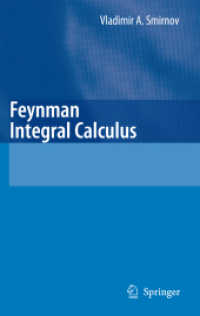- ホーム
- > 洋書
- > ドイツ書
- > Social Sciences, Jurisprudence & Economy
- > Politics, Society, Work
- > political science
Full Description
This book is a collection of 44 representative publications and papers by Milton Leitenberg. It allows publications that appeared in journals and books as well as unpublished work prepared for national and international organizations to appear in one place. This makes them accessible to researchers for years and decades to come. These studies made substantial contributions to the area of arms control, particularly on the subjects of nuclear weapons, wars and conflicts, Soviet military studies, biological weapons, and other related international security areas - all of which are of continued interest to security studies and political science audiences.
The primary audience is academics and practitioners in the arms control, security studies, and peace research fields. The book is useful for graduate studies in arms control and peace research. There is no similar book to this collection.
Contents
Chapter 1. Biological Weapons.- Chapter 2. The Technological Arms Race: Submarine-Launched Ballistic Missiles.- Chapter 3. Nuclear Weapon Testing Programme.- Chapter 4. World Stockpile of Nuclear Material.- Chapter 5. The Present State of the World's Arms Race.- Chapter 6. The Classic Scientific Ethic and Strategic Weapon Development.- Chapter 7. Non-Seismic Nuclear Detection.- Chapter 8. Memorandum: "International Level of Funding for Military Research and Development".- Chapter 9. America in Vietnam: Statistics of a War,.- Chapter 10. The Conversion Potential of Military Research and Development Expenditures.- Chapter 11. SALT II: The Race to Oblivion.- Chapter 12. Problems of Environmental Warfare: Weather and Climate Modification, the Evolution of an R&D Program into a Weapon System.- Chapter 13. Accidents of Nuclear Weapon Systems, 1945 to 1976.- Chapter 14. The Military Expenditures of Less Developed Nations as a Proportion of Their State Budgets.- Chapter 15. Disarmament andArms Control Since 1945, A Brief Survey.- Chapter 16. The Concerns of Developing Countries: I. Measure of Structural Violence, Nuclear Weapon Equivalents of Deaths in Developing Countries.- Chapter 17. World-wide Military Coups Since 1945: A Short Note on a Data Collections.- Chapter 18. NATO and WTO Long Range Theatre Nuclear Forces.- Chapter 19. Efforts at Reducing Defense Expenditure in the United States, 1960-1978.- Chapter 20. US Nuclear Weapon Targeting Policy.- Chapter 21. The Case of the Stranded Sub.- Chapter 22. Problems of the Reliability of Armament and Security Information.- Chapter 23. The Impact of the Worldwide Confrontation of the Great Powers: Aspects of Military Intervention and the Projection of Military Power.- Chapter 24. United States-Soviet Strategic Arms Control: The Decade of Détente 1980-1980, And A Look Ahead.- Chapter 25. The Soviet Union and the Lessons of World War II.- Chapter 26. A Return to Sverdlovsk: Allegations of Soviet Activities Related to Biological Weapons.-Chapter 27. What is Military R&D and How does it Function?.- Chapter 28. New Russian Evidence on the Korean War Biological Warfare Allegations: Background and Analysis.- Chapter 29. Just a 1-2 page description of Humanitarian Intervention and Other International Initiatives to Enforce Peace, February 22, 1993.- Chapter 30. Rwanda and Burundi Genocide: A Case Study of Neglect and Indifference.- Chapter 31. Just the Abstract page from Deaths in Wars and Conflicts in the 20th Century, Cornell University Peace Studies Program, Occasional Paper no 29 (3rd edition), June 2006.- Chapter 32. Assessing the Threat of Bioterrorism.- Chapter 33. Summary of The Soviet Biological Weapons Program. A History, with Raymond Zilinskas.- Chapter 34. Summary only from China's False Allegations of the Use of Biological Weapons by the United States During the Korean War, Cold War International History Project (CWIHP) Working Paper Series.- Chapter 35. The Hazards of Operations Involving Nuclear Weapons during the Cold War.- Chapter 36. "Did the SARS-CoV-2 virus arise from a bat coronavirus research program in a Chinese laboratory? Very possibly,".- Chapter 37. "China versus SARS".- Chapter 38. "False allegations of biological-weapons use from Putin's Russia".- Chapter 39. "Russian nuclear and biological disinformation undermines treaties on weapons of mass destruction".
-

- 和書
- ルポ M&A仲介の罠
-

- 電子書籍
- しがみついても無駄です【タテヨミ】第2…






